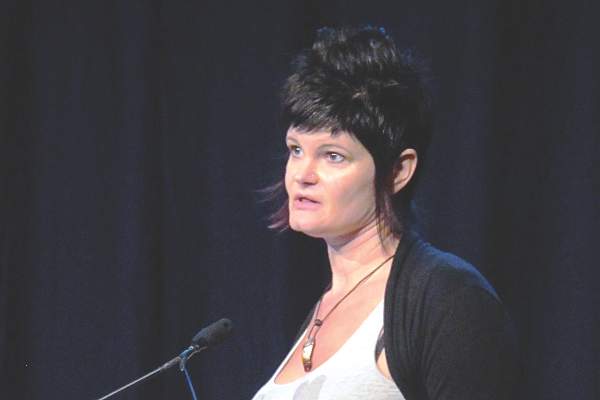User login
BRISBANE, AUSTRALIA – An internet-based testing referral service for sexually transmitted infections could take the pressure off overloaded clinics and reduce barriers to testing, according to new research.
Researchers reported data from a Vancouver-based pilot study of a virtual extension of clinic services called GetCheckedOnline.com. The service was offered to patients who were unable to get an immediate appointment at an STI clinic.
The service, which is being piloted in three clinic settings in Vancouver, is aimed at individuals who are asymptomatic and have not had STI contact.
It enables them to print out a requisition for a test for chlamydia, gonorrhea, syphilis, HIV, or hepatitis C, after completing a sexual history questionnaire.
Negative results are made available through the same website, but individuals who have positive results are asked to contact the clinic to receive their results. The clinic is also notified to ensure follow-up.
Devon Haag of the British Columbia Centre for Disease Control said the pilot was initiated in an attempt to address the long wait times for clinic appointments, with many patients unable to get an appointment for 3-4 weeks.
“We’ve been seeing increasing rates of STIs and at the same time a limited ability and availability of clinical services to meet the demands for timely testing and diagnosis,” Ms. Haag said at the World STI & HIV Congress 2015.
Analysis of data from the first month of the pilot study found that uptake and completion of testing varied considerably across test sites and the source of referral.
Among the 37 individuals who were given access codes to the website after being turned away from the provincial STI clinic – which is located within the BC Centre for Disease Control – 12 individuals went on to create an account on the site, and 10 of those got tested.
Among 108 individuals who contacted that same clinic by telephone and were referred to the service, 80 individuals (74%) created an account, and 62 of them (78%) were tested.
However, uptake was much lower at the two other clinics, with only 7 (19%) of those referred to the website creating an account. Ms. Haag said this may have been due to the nature of the two clinics, which were both located in nonprofit, community-based organizations in an area with a large population of gay men.
“We’ve heard anecdotally from both frontline clinicians and clients, that the clients are really happy with the services that they’re receiving at these clinics and actually would prefer to just come back into the clinic,” she said.
Overall, the pilot resulted in two positive test results and achieved a 2.9% increase in capacity at the provincial clinic.
“We demonstrated that referring clinic turnaways to GetCheckedOnline was feasible and in fact led to new STI diagnoses, so proof of concept was established,” Ms. Haag said.
The researchers also looked at the impact of promotional campaigns aimed at men who have sex with men, finding that these did achieve a significant increase in the number of people creating accounts, but this effect dropped off after the campaign ended.
Ms. Haag said that some clinic patients are now asking to use the online service rather than having to come into the clinic to get tested.
An audience member asked about the number of people who might have dropped out at the sexual health questionnaire stage of the process. While the 1-year data were yet to be analyzed, they do suggest that the questionnaire stage was associated with drop-offs, Ms. Haag said.
She reported having no financial disclosures.
BRISBANE, AUSTRALIA – An internet-based testing referral service for sexually transmitted infections could take the pressure off overloaded clinics and reduce barriers to testing, according to new research.
Researchers reported data from a Vancouver-based pilot study of a virtual extension of clinic services called GetCheckedOnline.com. The service was offered to patients who were unable to get an immediate appointment at an STI clinic.
The service, which is being piloted in three clinic settings in Vancouver, is aimed at individuals who are asymptomatic and have not had STI contact.
It enables them to print out a requisition for a test for chlamydia, gonorrhea, syphilis, HIV, or hepatitis C, after completing a sexual history questionnaire.
Negative results are made available through the same website, but individuals who have positive results are asked to contact the clinic to receive their results. The clinic is also notified to ensure follow-up.
Devon Haag of the British Columbia Centre for Disease Control said the pilot was initiated in an attempt to address the long wait times for clinic appointments, with many patients unable to get an appointment for 3-4 weeks.
“We’ve been seeing increasing rates of STIs and at the same time a limited ability and availability of clinical services to meet the demands for timely testing and diagnosis,” Ms. Haag said at the World STI & HIV Congress 2015.
Analysis of data from the first month of the pilot study found that uptake and completion of testing varied considerably across test sites and the source of referral.
Among the 37 individuals who were given access codes to the website after being turned away from the provincial STI clinic – which is located within the BC Centre for Disease Control – 12 individuals went on to create an account on the site, and 10 of those got tested.
Among 108 individuals who contacted that same clinic by telephone and were referred to the service, 80 individuals (74%) created an account, and 62 of them (78%) were tested.
However, uptake was much lower at the two other clinics, with only 7 (19%) of those referred to the website creating an account. Ms. Haag said this may have been due to the nature of the two clinics, which were both located in nonprofit, community-based organizations in an area with a large population of gay men.
“We’ve heard anecdotally from both frontline clinicians and clients, that the clients are really happy with the services that they’re receiving at these clinics and actually would prefer to just come back into the clinic,” she said.
Overall, the pilot resulted in two positive test results and achieved a 2.9% increase in capacity at the provincial clinic.
“We demonstrated that referring clinic turnaways to GetCheckedOnline was feasible and in fact led to new STI diagnoses, so proof of concept was established,” Ms. Haag said.
The researchers also looked at the impact of promotional campaigns aimed at men who have sex with men, finding that these did achieve a significant increase in the number of people creating accounts, but this effect dropped off after the campaign ended.
Ms. Haag said that some clinic patients are now asking to use the online service rather than having to come into the clinic to get tested.
An audience member asked about the number of people who might have dropped out at the sexual health questionnaire stage of the process. While the 1-year data were yet to be analyzed, they do suggest that the questionnaire stage was associated with drop-offs, Ms. Haag said.
She reported having no financial disclosures.
BRISBANE, AUSTRALIA – An internet-based testing referral service for sexually transmitted infections could take the pressure off overloaded clinics and reduce barriers to testing, according to new research.
Researchers reported data from a Vancouver-based pilot study of a virtual extension of clinic services called GetCheckedOnline.com. The service was offered to patients who were unable to get an immediate appointment at an STI clinic.
The service, which is being piloted in three clinic settings in Vancouver, is aimed at individuals who are asymptomatic and have not had STI contact.
It enables them to print out a requisition for a test for chlamydia, gonorrhea, syphilis, HIV, or hepatitis C, after completing a sexual history questionnaire.
Negative results are made available through the same website, but individuals who have positive results are asked to contact the clinic to receive their results. The clinic is also notified to ensure follow-up.
Devon Haag of the British Columbia Centre for Disease Control said the pilot was initiated in an attempt to address the long wait times for clinic appointments, with many patients unable to get an appointment for 3-4 weeks.
“We’ve been seeing increasing rates of STIs and at the same time a limited ability and availability of clinical services to meet the demands for timely testing and diagnosis,” Ms. Haag said at the World STI & HIV Congress 2015.
Analysis of data from the first month of the pilot study found that uptake and completion of testing varied considerably across test sites and the source of referral.
Among the 37 individuals who were given access codes to the website after being turned away from the provincial STI clinic – which is located within the BC Centre for Disease Control – 12 individuals went on to create an account on the site, and 10 of those got tested.
Among 108 individuals who contacted that same clinic by telephone and were referred to the service, 80 individuals (74%) created an account, and 62 of them (78%) were tested.
However, uptake was much lower at the two other clinics, with only 7 (19%) of those referred to the website creating an account. Ms. Haag said this may have been due to the nature of the two clinics, which were both located in nonprofit, community-based organizations in an area with a large population of gay men.
“We’ve heard anecdotally from both frontline clinicians and clients, that the clients are really happy with the services that they’re receiving at these clinics and actually would prefer to just come back into the clinic,” she said.
Overall, the pilot resulted in two positive test results and achieved a 2.9% increase in capacity at the provincial clinic.
“We demonstrated that referring clinic turnaways to GetCheckedOnline was feasible and in fact led to new STI diagnoses, so proof of concept was established,” Ms. Haag said.
The researchers also looked at the impact of promotional campaigns aimed at men who have sex with men, finding that these did achieve a significant increase in the number of people creating accounts, but this effect dropped off after the campaign ended.
Ms. Haag said that some clinic patients are now asking to use the online service rather than having to come into the clinic to get tested.
An audience member asked about the number of people who might have dropped out at the sexual health questionnaire stage of the process. While the 1-year data were yet to be analyzed, they do suggest that the questionnaire stage was associated with drop-offs, Ms. Haag said.
She reported having no financial disclosures.
FROM THE WORLD STI & HIV CONGRESS 2015
Key clinical point: An internet-based testing referral service for sexually transmitted infections could increase testing capacity.
Major finding: The Internet-based service achieved a 2.9% increase in capacity for one STI clinic.
Data source: Pilot study at three Vancouver STI clinics.
Disclosures: Ms. Haag reported having no financial disclosures.

